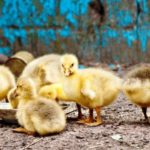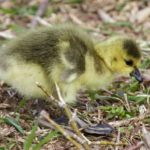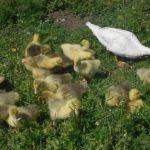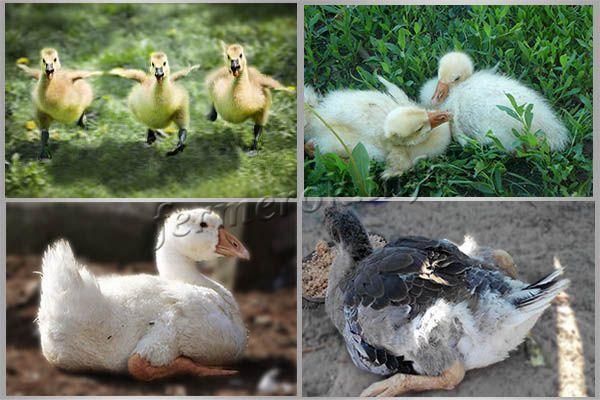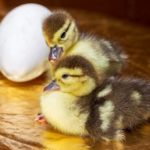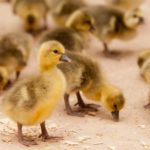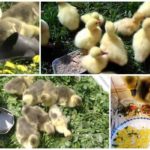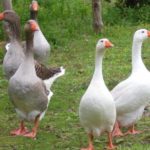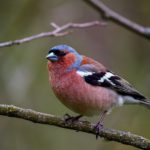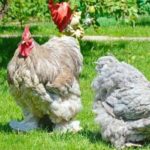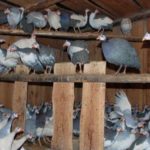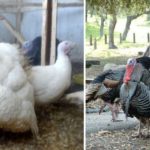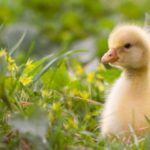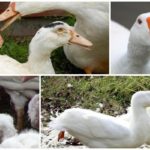The health of the feathered inhabitants of the household is under constant control of farmers. One sick bird can infect the entire flock. The appearance of dangerous symptoms in young animals is of particular concern. Therefore, the question of why goslings become weak, fall on their feet, and how to treat them often worries owners. Measures to save the chicks should be taken immediately.
Why do geese fall on their feet and how to treat it?
The causes of disease in goslings may be different. The fragile body is affected by temperature changes, unbalanced nutrition and unsanitary conditions in the poultry house.The danger is posed by infections, which often result in the death of not only chicks, but also adult birds. If you find a gosling that is unsteady on its feet, it is better to begin treatment immediately. This symptom is characteristic of many ailments.
Viral enteritis
The disease often occurs in goslings 5 or 12 days of age, less often in 3-week-old goslings. The disease primarily affects the liver, and also affects the heart and gastrointestinal tract. The virus is most active in the first half of spring. The acute course of the disease is accompanied by symptoms:
- The goslings fall on their feet and show minimal activity.
- The chicks lose their appetite.
- There is mucous discharge from the eyes and nose.
- The young are cold, gather in groups and try to warm up near the lamp.
- Diarrhea begins, accompanied by the release of blood clots.
- Feathers fall out.
The disease often ends in the death of chicks. Therefore, when the goslings have sat on their feet, the farmer needs to clarify the diagnosis and begin treatment:
- It is useful to add a solution of manganese (5%) to water.
- Furazolidone mixed into food is given for 10 days.
- The norm for Biomycin is 20 mg per 1 kilogram of weight.
If enteritis is detected, a quarantine is declared on the farm. The carcasses of dead birds, as well as incubation material, are subject to destruction. The goslings are vaccinated. Emergency measures are canceled 2 months after the end of the disease.
Mycotoxicosis
The disease develops in goslings when they consume low-quality food with mold. The type of fungus can only be determined through laboratory testing of food products. Most often, pathogenic bacteria are found in sunflower, corn, barley or wheat.
Signs of illness:
- Loose stools with blood.
- Refusal of food.
- Weakness and loss of fluff.
Mycotoxicosis develops rapidly and destroys the entire brood of chicks in 2 days. Autopsy of dead geese shows that the gastrointestinal tract system is affected.
The poultry house in which cases of infection have been identified is cleaned and the premises are treated with antiseptic materials. Lost food is replaced with new food. “Mycosorb” or “Symbitox” is introduced into food to avoid the reappearance of fungal mold in products.
Salmonellosis
Salmonella is dangerous for goslings in the first month of life. The disease manifests itself in different ways:
| Bird age | Course of the disease | Signs |
| Newborn chicks | Rapid development | Goslings die immediately after birth |
| Up to 10 days | Acute course | Cramps, diarrhea, loss of appetite and motor activity. After 1-3 days, mortality of young animals is possible |
| Adult birds | Chronic form | No obvious symptoms |
When the goslings sit on their feet, the farmer should immediately contact a veterinarian. If the doctor confirms salmonellosis, treatment begins. The following drugs are added to the feed:
- "Levomethicin" at the rate of 30 mg per kilogram of bird weight.
- Probiotics. “Bifidumbacterin” has proven itself well.
- Add 0.5 ml of Baytril to the water for each liter.
Restrictive measures are being introduced on the farm. Infected birds are isolated from healthy birds. The livestock is vaccinated. Organize large-scale disinfection of the poultry house. Goose meat is used only after 2 weeks after completing a course of antibiotics.
Perosis
With a deficiency of B vitamins and manganese, goslings have difficulty moving.Perosis is most often caused by an unbalanced diet. Lack of nutrients slows down the growth of long bones. Ligaments and tendons weakened as a result of the disease cannot support the weight of the bird.
If the goslings fall and do not get up, this should alert the farmer. Veterinarians advise inspecting all livestock. Other signs of pathology:
- Bones increase in diameter.
- Against the background of joint deformation, swelling of the limbs develops.
- The feather cover thins out, and bald patches appear.
- Birds lose their cloaca.
When the embryo is infected, the goslings die a few days after emerging from the shell. In other cases, complex therapy is prescribed:
- 3 mg of manganese sulfate and choline are added to the chicks' food.
- The drink is also enriched with a solution of potassium permanganate.
- All livestock are transferred to purchased feed.
- In summer, the diet of goslings is supplemented with plants such as alfalfa or clover.
Poultry meat is suitable for sale, but eggs for incubation are discarded.
Rickets
This disease is caused by a lack of vitamin D3. Deficiency occurs due to improper nutrition and violation of the conditions of keeping young animals. As a result, the bird’s body stops absorbing calcium and phosphorus, which are important for normal bone development. An advanced disease causes the goslings to die.
When rickets is observed:
- Impaired coordination of movements.
- Softening the gosling's beak.
- Feather fragility.
- Frequent and loose stools.
Treatment includes a review of the chicks' diet:
- Fish oil is added to the feed. Per kilogram of food, 1 gram of the substance is enough.
- Bird menu items include shells, crushed egg shells, or crumbled chalk.
- Dry mixtures are enriched with 2 drops of concentrated solution D
The therapy is supplemented with ultraviolet irradiation sessions.Start with 2 minutes and gradually increase the time by 3 times. Veterinarians usually prescribe a 2-week course. It is useful to feed the chicks with calcium gluconate and a solution of potassium permanganate. This drink helps with many diseases.
Preventive methods
Preventive measures help prevent infectious diseases. The most effective way to stop the spread of the virus is to keep the gosling housing area clean. Recommendations from experienced poultry farmers:
- Before placing the chicks, organize a thorough cleaning of the room and whitewash the walls and ceiling.
- Provide ventilation for the poultry house. Bacteria do not like fresh air and multiply in musty environments. But it is important to prevent drafts from occurring.
- Every day the chicks are released for a walk.
- Routine vaccinations are an effective means of preventing diseases.
- A balanced diet and the inclusion of mineral supplements and vitamins in the birds’ diet will strengthen the immunity of the winged livestock.
- After feeding, leftover food is removed to avoid food spoilage.
It is important to conduct regular livestock inspections. Contact a veterinarian if the goslings fall on their feet and stop moving. Uncharacteristic behavior of chicks signals an emerging problem.
If you do not neglect preventive methods and advice from other farmers, the goslings will grow up healthy. The efforts to clean the premises and the costs of fresh food and veterinary consultations cannot be compared with the losses from the death of a bird.




